Pseudorabies detected in California feral swine
Disease was eradicated from U.S. commercial pig industry in 2004.
January 10, 2024

In an ongoing effort to watch and safeguard against emerging threats in feral swine populations, the USDA and Wildlife Services has identified the presence of Pseudorabies virus antibodies in samples collected from two feral pigs tested in Calaveras County. Pseudorabies is a disease that can be spread to other livestock or domestic animals.
Samples were taken on Oct. 25, 2023 from two feral pigs. Samples were tested and results were reported as positive for PRV antibodies on Jan. 3, 2024. These samples were taken within a 10-mile radius of Burson, California and both pigs were euthanized to prevent further spread. This marks the first discovery of PRV in Calaveras County.
Virus details
Pseudorabies is a viral infection known to affect domestic and feral swine, cattle, dogs, cats, sheep and goats. The virus causes reproductive problems in livestock and deer and, in some cases, death—particularly in exposed cats, dogs and young or chronically stressed pigs. PRV is not a form of rabies.
Transmission
PRV is primarily spread through direct animal-to-animal (nose-to-nose) contact between an infected pig and a noninfected pig or other susceptible species. It may also be spread by breeding. The virus can spread from herd-to-herd and farm-to-farm if present on inanimate objects, such as boots, clothing, feed, trucks and equipment.
While there are limited documented cases of humans contracting PRV, the virus is often fatal to dogs and cats. Transmission to dogs and cats typically occurs through contact, bite wounds or the consumption of raw feral pig meat.
Symptoms
Symptoms in pigs can vary. Piglets show symptoms through central nervous systems signs, incoordination, sneezing, coughing and can lead to a high number of deaths. In adult pigs, symptoms can include coughing, fever, pneumonia, nervous system issues and reproductive problems such as abortions or stillbirths. Adult pigs often have lower number of deaths. A pig can carry the virus for long periods of time and not show any symptoms.
Although rare, humans can contract PRV. It presents as encephalitis, but it cannot be directly linked to PRV if a human is admitted with this symptom.
Cats and dogs may show signs and symptoms such as excessive drooling, severe itching, fever, vomiting and seizure. Contrary to what the name suggests, pseudorabies in not related it rabies, but signs and symptoms can be similar. It can be fatal in cats and dogs that come into contact with swine infected with the virus.
Prevention
Contact with feral swine is the most common method of spreading PRV to other livestock and domestic animals. Physical barriers such as enclosures that are double fenced in areas where feral hogs are present can help prevent contact between feral hogs and livestock or pets. Ensure separation and quarantine of livestock from feral animals or newly introduced livestock. Follow sanitary procedures in general day-to-day practices.
Treatment
There is no treatment for PRV. Antibiotic medications can be used to control secondary bacterial infections. Vaccines are available for livestock, require USDA approval for use, and can be used to assist in outbreak response efforts.
If you are a producer or swine owner and notice any serious health issues related to reproduction, the nervous system, respiratory concerns, or any sudden and unexpected deaths among sows, boars or newborn piglets, call your veterinarian. If the issue is PRV, local, state and federal animal health officials will also become involved in the investigation.
If you or someone you know is experiencing feral hog issues, please the call Calaveras County Department of Agriculture at 209-754-6504.
For additional information on Pseudorabies, please visit USDA’s website.
Wildlife Services will continue its efforts to watch for the disease, collecting samples from the area and other sites in Calaveras County throughout 2024.
You May Also Like



